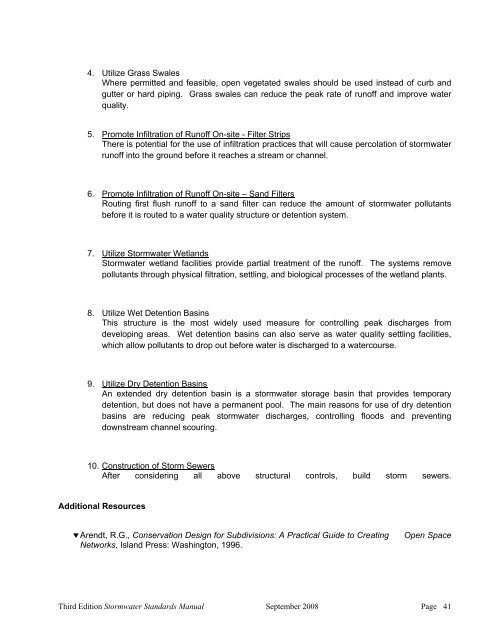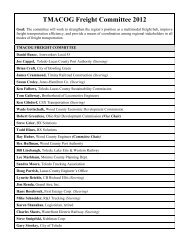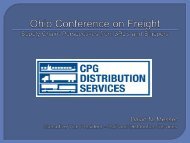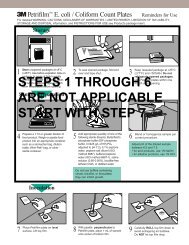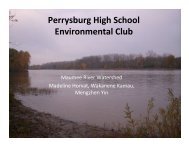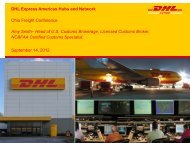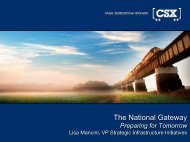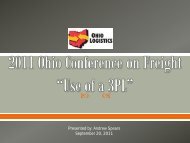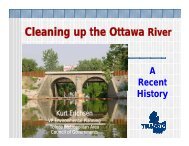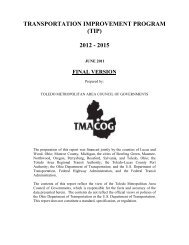- Page 2 and 3: TMACOG STORMWATER MANAGEMENT STANDA
- Page 4 and 5: 3.5.3 Drainage Structure Location .
- Page 6 and 7: 8.2.2 Regulatory Floodway..........
- Page 8 and 9: GROUND WATER TABLE ................
- Page 10 and 11: TN ................................
- Page 12 and 13: Flow Around Ends ..................
- Page 14 and 15: FIGURES Figure 1-1 Effects of Urban
- Page 16 and 17: Executive Summary The Stormwater Co
- Page 18 and 19: Chapter 8: Regulatory Floodplain an
- Page 20 and 21: has taken 30 years to start to iden
- Page 22 and 23: 1.3.1 Changes in Watershed Hydrolog
- Page 24 and 25: A well-designed plan requires consi
- Page 26 and 27: 1.5.1 Nonstructural Controls Nonstr
- Page 28 and 29: CHAPTER 2 - Stormwater Management S
- Page 30 and 31: applications. These regulations are
- Page 32 and 33: • Description of how the Runoff R
- Page 34 and 35: Lucas County Lucas County Engineer
- Page 36 and 37: Township of Richfield 3951 Washburn
- Page 38 and 39: CHAPTER 3 - RUNOFF REDUCTION HIERAR
- Page 42 and 43: Schueler, T. R., Site Planning for
- Page 44 and 45: Rainfall Intensities in Inches/Hour
- Page 46 and 47: f. HEC-RAS used for FEMA Studies 3.
- Page 48 and 49: 3.5.2 Capacity Storm sewers should
- Page 50 and 51: a. All materials should be of such
- Page 52 and 53: 4.1.1 Exclusions: Activities that a
- Page 54 and 55: • Total area of the site and the
- Page 56 and 57: stabilization, vegetative buffer st
- Page 58 and 59: The sediment settling pond volume c
- Page 60 and 61: for roads or utilities), the projec
- Page 62 and 63: SWP3 is adequate, or whether additi
- Page 64 and 65: work best in gently sloping areas (
- Page 66 and 67: function by slowing runoff velociti
- Page 68 and 69: Sand filtration systems are most be
- Page 70 and 71: limited to a height of 18 inches. T
- Page 72 and 73: Example of a Perimeter Sand Filter
- Page 74 and 75: 5.3 Runoff Treatment 5.3.1 Bioreten
- Page 76 and 77: Site Applicability Bioretention is
- Page 78 and 79: Introducing Runoff Runoff must be i
- Page 80 and 81: Plan View Of A Bioretention Cell Fi
- Page 82 and 83: Underdrain Gravel Underdrain gravel
- Page 84 and 85: Type Botanical Name Common Name F T
- Page 86 and 87: • The cell is draining properly a
- Page 88 and 89: General Applicability Land Area Con
- Page 90 and 91:
energy of the inflow. Stone riprap
- Page 92 and 93:
Maintenance Maintenance Agreement A
- Page 94 and 95:
5.3.3 Wet Detention Ponds Wet deten
- Page 96 and 97:
Minimal Water Supply To avoid drawd
- Page 98 and 99:
Sediment Removal Sediment removal i
- Page 100 and 101:
5.3.4 Dry Extended Detention Basins
- Page 102 and 103:
Riser Design Hoods or trash racks s
- Page 104 and 105:
Example of a Dry Extended Detention
- Page 106 and 107:
CHAPTER 6 - ILLICIT DISCHAGE DETECT
- Page 108 and 109:
Should be the same agency as tracin
- Page 110 and 111:
Sewer Conversion: Areas that were o
- Page 112 and 113:
6.4.2 Dry Weather Field Screening T
- Page 114 and 115:
6.5.1 Local Agency Contact Informat
- Page 116 and 117:
CHAPTER 7 - Riparian Setbacks _____
- Page 118 and 119:
Floodplains perform crucial roles,
- Page 120 and 121:
are ecologically compatible and emp
- Page 122 and 123:
yards, recycling facilities, quarri
- Page 124 and 125:
8.2 Lands Subject to These Control
- Page 126 and 127:
more than 1.0 foot. (Some jurisdict
- Page 128 and 129:
• Be consistent with the need to
- Page 130 and 131:
• Category 1 - wetlands are consi
- Page 132 and 133:
eissued (extended), and revoked fro
- Page 134 and 135:
Oak Openings Region Boundary Figure
- Page 136 and 137:
Authorized representatives of local
- Page 138 and 139:
Base Flood The flood having one per
- Page 140 and 141:
1. Dry Detention Basin A basin that
- Page 142 and 143:
Fill Added earth that is designed t
- Page 144 and 145:
Infiltration The absorption of wate
- Page 146 and 147:
Ohio Rapid Assessment Method A mult
- Page 148 and 149:
Regulatory Floodway The channel and
- Page 150 and 151:
Soil and Water Conservation Distric
- Page 152 and 153:
Temporary Soil Erosion and Sediment
- Page 154 and 155:
Appendix B: Best Management Practic
- Page 156 and 157:
Example of Matting Installation Fig
- Page 158 and 159:
Description Applying a protective l
- Page 160 and 161:
6. Permanent Seeding Description Pe
- Page 162 and 163:
Design Guidelines Site Preparation
- Page 164 and 165:
Example of a Sediment Trap Figure A
- Page 166 and 167:
Safety Sediment basins shall be con
- Page 168 and 169:
Example of a Sediment Basin Figure
- Page 170 and 171:
Example of Silt Fence Installation
- Page 172 and 173:
Examples of Inlet Protection Techni
- Page 174 and 175:
Example of Construction Entrance Fi
- Page 176 and 177:
Maintenance Mud spilled, dropped, w
- Page 178 and 179:
Figure Appendix B- 9 Example of Str
- Page 180 and 181:
summary of the activities the juris
- Page 182 and 183:
Riparian Resolution for Township RI
- Page 184 and 185:
Riparian Resolution for Township SE
- Page 186 and 187:
Riparian Resolution for Township 26
- Page 188 and 189:
Riparian Resolution for Township 1.
- Page 190 and 191:
Riparian Resolution for Township ap
- Page 192 and 193:
Riparian Resolution for Municipalit
- Page 194 and 195:
Riparian Resolution for Municipalit
- Page 196 and 197:
Riparian Resolution for Municipalit
- Page 198 and 199:
Riparian Resolution for Municipalit
- Page 200 and 201:
Riparian Resolution for Municipalit
- Page 202 and 203:
Conservation Development for Townsh
- Page 204 and 205:
Conservation Development for Townsh
- Page 206 and 207:
Conservation Development for Townsh
- Page 208 and 209:
Conservation Development for Munici
- Page 210 and 211:
Conservation Development for Munici
- Page 212 and 213:
Conservation Development for Munici
- Page 214 and 215:
Lucas County Stormwater Quality Rul
- Page 216 and 217:
Sediment and Erosion Control Ordina
- Page 218 and 219:
Sediment and Erosion Control Ordina
- Page 220 and 221:
Sediment and Erosion Control Ordina
- Page 222 and 223:
Sediment and Erosion Control Ordina
- Page 224 and 225:
Sediment and Erosion Control Ordina
- Page 226 and 227:
Sediment and Erosion Control Ordina
- Page 228 and 229:
Sediment and Erosion Control Ordina
- Page 230 and 231:
Sediment and Erosion Control Ordina
- Page 232 and 233:
Sediment and Erosion Control Ordina
- Page 234 and 235:
Sediment and Erosion Control Ordina
- Page 236 and 237:
Sediment and Erosion Control Ordina
- Page 238 and 239:
Illicit Discharge & Illegal Connect
- Page 240 and 241:
Illicit Discharge & Illegal Connect
- Page 242 and 243:
Illicit Discharge & Illegal Connect
- Page 244 and 245:
Illicit Discharge & Illegal Connect
- Page 246:
Illicit Discharge & Illegal Connect


